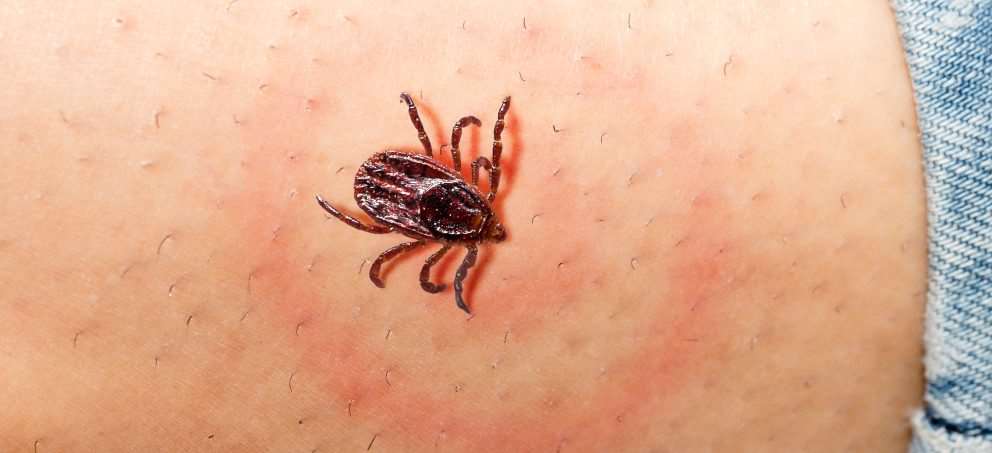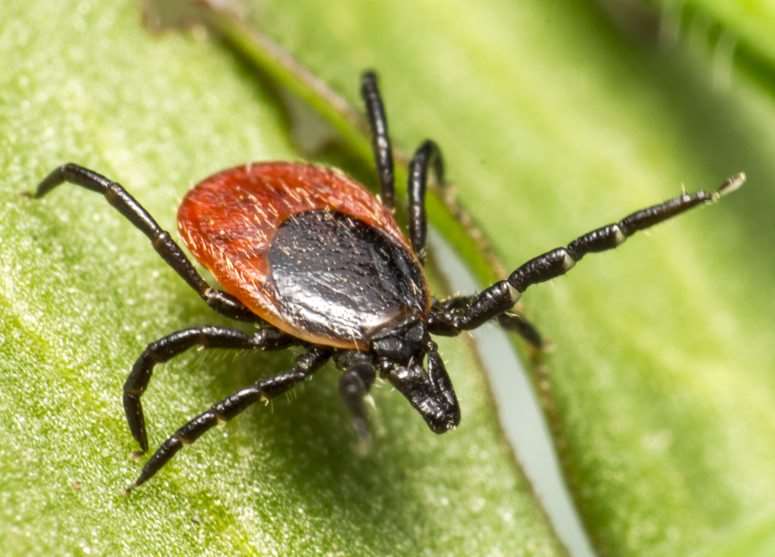Lyme disease, also known as Lyme borreliosis, is a vector-borne disease caused by the Borrelia bacterium, which is spread by ticks in the genus Ixodes. The most common sign of infection is an expanding red rash, known as erythema migrans (EM), which appears at the site of the tick bite about a week afterwards. The rash is typically neither itchy nor painful. Lyme disease is most commonly found in temperate regions of the Northern Hemisphere, including North America, Europe, and Asia. In Europe, the disease is most common in the western and central parts of the continent, although it has been reported in many countries throughout the region.
Early signs and symptoms
- Fever, chills, headache, fatigue, muscle and joint aches, and swollen lymph nodes may occur in the absence of rash
- Erythema migrans (EM) rash
- Occurs in approximately 70 to 80 percent of infected persons
- Begins at the site of a tick bite after a delay of 3 to 30 days (average is about 7 days)
- Expands gradually over several days reaching up to 12 inches or more (30 cm) across
- May feel warm to the touch but is rarely itchy or painful
- May appear on any area of the body
Later Signs and Symptoms (days to months after tick bite)
- Severe headaches and neck stiffness
- Additional EM rashes on other areas of the body
- Facial palsy (loss of muscle tone or droop on one or both sides of the face)
- Arthritis with severe joint pain and swelling, particularly the knees and other large joints.
- Intermittent pain in tendons, muscles, joints, and bones
- Heart palpitations or an irregular heart beat (Lyme carditis)
- Episodes of dizziness or shortness of breath
- Inflammation of the brain and spinal cord
- Nerve pain
- Shooting pains, numbness, or tingling in the hands or feet

How does Lyme disease spread?

- Lyme disease is primarily spread through the bite of an infected tick.
- The bacteria that cause Lyme disease, known as Borrelia burgdorferi, are carried by certain species of ticks, including the deer tick (Ixodes scapularis) in the United States and the sheep tick (Ixodes ricinus) in Europe.
- Ticks become infected with the bacteria when they feed on infected animals, such as mice, squirrels, and deer.
- When an infected tick bites a human, the bacteria can be transmitted through the tick’s saliva into the person’s bloodstream, potentially leading to infection with Lyme disease.
- It’s important to note that not all ticks carry Lyme disease, and not all tick bites will result in infection.
- The risk of contracting Lyme disease after a tick bite depends on a variety of factors, including the type of tick, the duration of the bite, and the prevalence of Lyme disease in the local area.
Diagnosis and Testing
- Currently a two-step testing process for Lyme disease is recommended.Both steps are required and can be done using the same blood sample.
- If this first step is negative, no further testing is recommended. If the first step is positive or indeterminate (sometimes called “equivocal”), the second step should be performed.
- The overall result is positive only when the first test is positive (or equivocal) and the second test is positive (or for some tests equivocal).
Treatment
- No human vaccines for Lyme disease are currently available.
- The only human vaccine to advance to market was LYMErix, which was available starting in 1998 before being pulled from the market in 2002.
- The vaccine candidate VLA15 was scheduled to start a phase 3 trial in the third quarter of 2022, and other research is ongoing.
- Antibiotics are the primary treatment.
- The specific approach to their use is dependent on the individual affected and the stage of the disease.
- For most people with early localized infection, oral administration of doxycycline is widely recommended as the first choice, as it is effective against not only Borrelia bacteria but also a variety of other illnesses carried by ticks.

Recent spike in cases in UK
Lyme disease occurs regularly in Northern Hemisphere temperate regions. An estimated 476,000 people a year are diagnosed and treated for the disease in the United States. Over 200,000 people a year are diagnosed and treated in Europe. Despite its rarity in the United Kingdom, Lyme disease has been on the rise in recent months. Since 2001, the number of cases has increased by a factor of 3,600, with over 100 cases reported by the Health Protection Agency (HPA) in The government estimates that there are between 3,000 and 4,000 cases of the disease annually in England and Wales. Current Lyme disease endemic areas in the United Kingdom include the New Forest, other southern wooded and heathland regions, Exmoor, Dartmoor, Thetford Forest, Lake District, and the Scottish Highlands and Islands. An estimated 10 percent of ticks in the United Kingdom transmit Lyme disease.
Borrelia burgdorferi sensu stricto, Borrelia afzelli, and Borrelia garinii are the most prevalent pathogenic variants in the United Kingdom. Neuroborelliosis is the most common complication in the United Kingdom, while myocarditis is uncommon and death from conduction disease or carditis is exceedingly uncommon.

( Link: https://lymediseaseuk.com/2020/05/09/wake-up-to-lyme-campaign-2020/image-from-ios-1-3/)
There are several factors that have contributed to a spike in Lyme disease cases in the UK, including:
- Increased awareness and testing: As awareness of Lyme disease grows, more people started seeking testing and diagnosis for the disease, leading to an increase in reported cases.
- Changes in climate and environment: Lyme disease is carried by ticks, which thrive in humid and wooded areas. Changes in climate and land use is also contributing to an increase in the number of ticks and their spread to new areas.
- Increased outdoor activities: People who spend more time outdoors, such as hikers, campers, and hunters, are at higher risk of being bitten by ticks and contracting Lyme disease. As more people engage in outdoor activities, the risk of exposure to ticks and Lyme disease increases.

Recommendations
Workplace:
- Provide information and training to employees about Lyme disease, including how it is spread, common symptoms, and how to prevent tick bites.
- Provide employees who work outdoors with appropriate protective clothing, such as long-sleeved shirts and pants, as well as insect repellent and tick removal tools.
- Regularly maintain outdoor areas by keeping grass and bushes trimmed, removing leaf litter, and using appropriate pest control measures to reduce the tick population.
- Encourage employees who work outdoors to perform regular tick checks, especially after spending time in wooded or grassy areas.
- Encourage employees to report any tick bites or symptoms of Lyme disease they experience, and provide information on how to seek medical attention promptly.
- Develop a plan for managing ticks on your property, which may include using tick-repellent landscaping and applying tick-control products.
- Consider limiting outdoor work during peak tick season, typically from April to September, or scheduling outdoor work during times of the day when ticks are less active.
- Consider providing coverage for Lyme disease testing and treatment for employees who may be at higher risk of exposure, such as those who work outdoors.
- Businesses can consider contingency measures such as remote working options in case the property location is vulnerable to the risk of spread.
- Businesses can ensure installing window screens, coils, insecticides and vapour dispensing machines to protect from tick bites. Adequate sanitation measures should be taken up at regular intervals at the workplace.
General:
- Wear long-sleeved shirts and pants, and tuck your pants into your socks or boots when spending time outdoors in wooded or grassy areas.
- Apply insect repellent containing DEET, picaridin, or other EPA-approved ingredients to exposed skin and clothing.
- Perform a thorough tick check after spending time outdoors, especially in areas where ticks are common. Check your entire body, including your scalp, and remove any ticks promptly.
- Keep your yard and outdoor areas free of leaf litter, tall grass, and brush, and consider using tick-control products.
- Take a shower within two hours after being outdoors to wash off any unattached ticks and reduce the risk of tick bites.
- Be aware of common symptoms of Lyme disease, such as a rash or fever, and seek medical attention promptly if you experience these symptoms.
- To avail Lyme disease diagnostic service from official designated agency of Rare and Imported Pathogens Laboratory y (RIPL), email on- lyme.ripl@phe.gov.uk or contact- 01980 61234
- For finding regional emergency centres visit on https://www.gov.uk/ government/collections/contacts-public-health-england-regions-localcentres-and-emergency


